Horizon Lies
Text by Stella Bottai
Photographs by Giovanna Silva
Everything local is famous when you are young, since your direct knowledge of the world coincides with your surroundings. When in Federico Fellini’s Amarcord, ‘il Titta’ (the director’s alter ego, played by a young Bruno Zanini) pays a visit to the tabaccheria of the village and succeeds in the challenge of lifting the voluptuous tabaccaia up in his arms, his heroic attempt is comparable to the great deeds of Hercules, or the strenuous task of Sisyphus. The tabaccaia, incidentally, was impersonated by Italian actress Maria Antonietta Beluzzi, whose body measurements add weight to the myth, literally: 173cm tall, 123cm bust, 88cm waistline and 132cm hips. Beluzzi was from Bologna, the birthplace of my grandmother Fulde, now 86, who was quite a beautiful lady in her heyday. The legend in our family goes that Fellini saw her walking on the high street in Bologna with her husband, my grandfather, and asked her to play ‘La Gradisca’, the village beauty in Amarcord. Nonno did not agree to it, the rest of the story remains a ‘What if…’.
The island of Stromboli is a tiny drop of volcanic land, surrounded by temperamental waters, geographically remote, logistically difficult and conceptually elsewhere. Everything there feels ultimately local and famous, and also timeless, whether you are young or old. And this doesn’t have much to do with the ubiquitous images of a forlorn Ingrid Bergman in Roberto Rossellini’s film, though it is true that the landscape has not changed much since then. Rather, there is something archetypal on this island – something that emerged strongly during the course of this year’s Volcano Extravaganza.
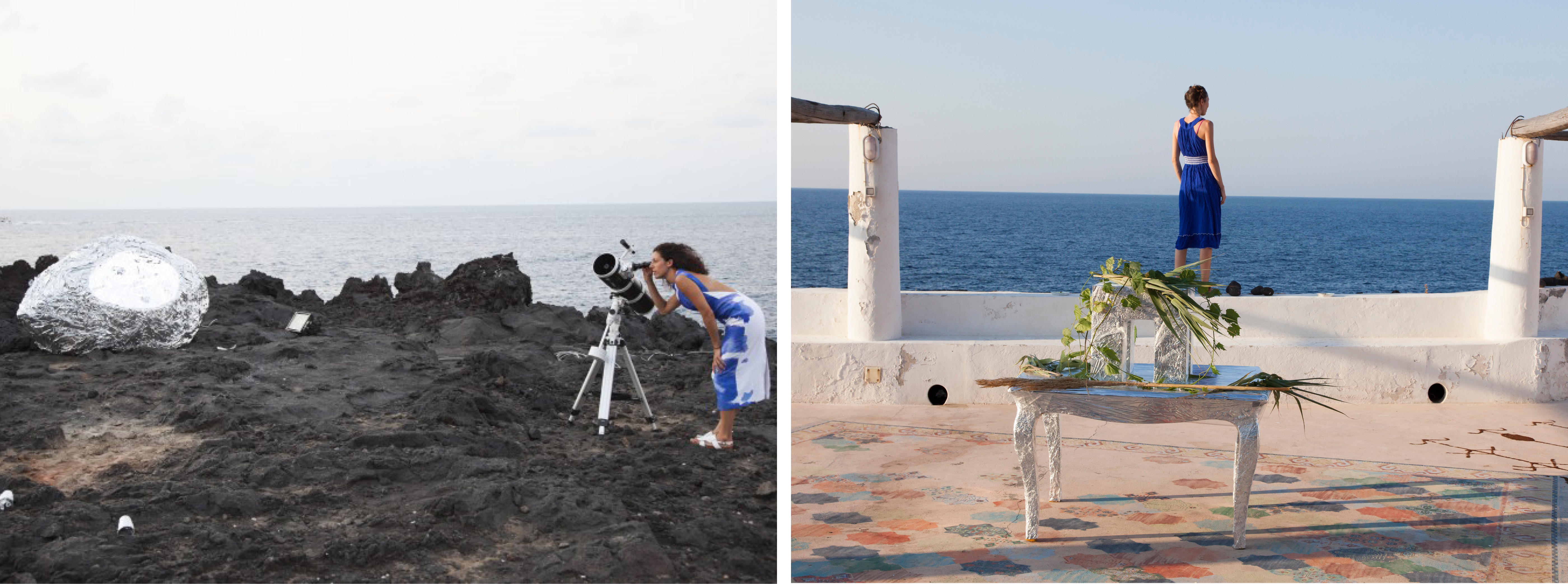
The first time I visited Stromboli in 2014 I was told to meet someone called Gioacchino, ‘the King of Stromboli’, who would be able to help, should I need anything during my stay. Gioacchino’s phone number is still saved in my mobile under ‘Gioacchino’, without a surname. Nobody in Stromboli requires a surname, in the same way that things are not referred to as ‘a’ but as ‘the’. Everyone and everything act as ‘the one and only’, iconic characters of an unscripted play which points to the universal. Upon stepping on this rocky Mediterranean land, whether for the first or tenth time, its geographical remoteness, its extreme, timeless and natural elements enable the mind to find the absolute in the finitude.
Carl Jung wrote that every modern person, however high their conscious development, is still an archaic being in the deepest levels of the psyche. Primordial images, that is, archetypes, inhabit the dark territories that pre-date our persona. The title of this year’s edition of Volcano Extravaganza, In Favour of a Total Eclipse, began as a statement in praise of shadows. For ten days, in July 2015, artists and participants embarked on a quest for the archaic ancestors of our collective subconscious.
The horizon is that constant line defining our limits of perception’, Christodoulos Panaiyotou told us in the introduction to his lecture Dying on Stage, held on the last day of the festival. ‘The horizon might be the biggest lie of all, or the only definite line in nature. It is a line reminding us of our finitude. It is as far as we can see but also, it embodies the knowledge that there is more beyond that we cannot see.’ As we live in a time that increasingly aspires to overcome finitude, horizons might collapse entirely at some point. How would that feel, I wonder.
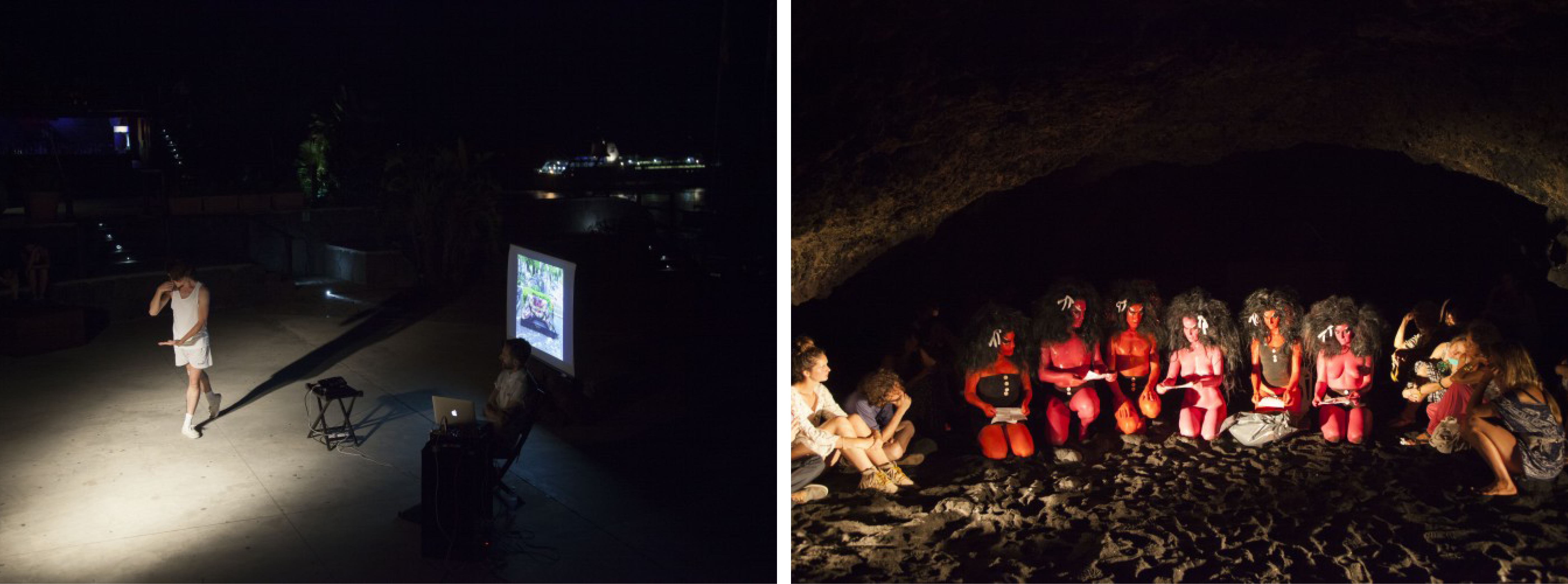
Limits make myths possible. Take Kembra Pfahler’s performances, which took place on two different days of the festival. In one instance, Pfahler invited a group of participants (myself included) to dress up alongside her and stage The Voluptuous Horror of Karen Black inside a sea cave. There were augmented eyelashes, painted bodies, hair built up to the volume of a hill – or rather, of Stromboli’s volcano – and facial make-up to give everyone the same look. While making it hardly possible for us to move gracefully, these props turned us into mythical, grotesque creatures, as we appeared inside a grotto.
Human activity is influenced to a great extent by instincts – according to Jung, these are of five main types: hunger, sexuality, activity, reflection, and creativity. While they never cease to push and pull our behaviour in several directions, not always where we hoped, there is an innate value to how instincts interplay and empower our will to act. The first day of In Favour of a Total Eclipse paid tribute to the possibility of a further layer of influence coming from the celestial bodies. The 17th of July, the opening evening of the festival, was a night of New Moon: astronomically significant and, symbolically, a portal for new beginnings. New Moons are a time to set intentions, and come face-to-face with one’s instincts. Food-freak Michal Gnilka served a lunar dinner, followed by a screening-cum-volcanic-landscape of Kenneth Anger’s legendary film Lucifer Rising. Brian Butler’s experimental ritual included low-frequency sounds that interfered with people’s minds. Kembra Pfahler’s forcefulness exploded in the live making of her butt prints series, while T De Long’s contribution rebalanced the energies of the collective ritual introducing a flow of positive sound waves. All instincts, one by one, were teased, represented, and put to rest again.
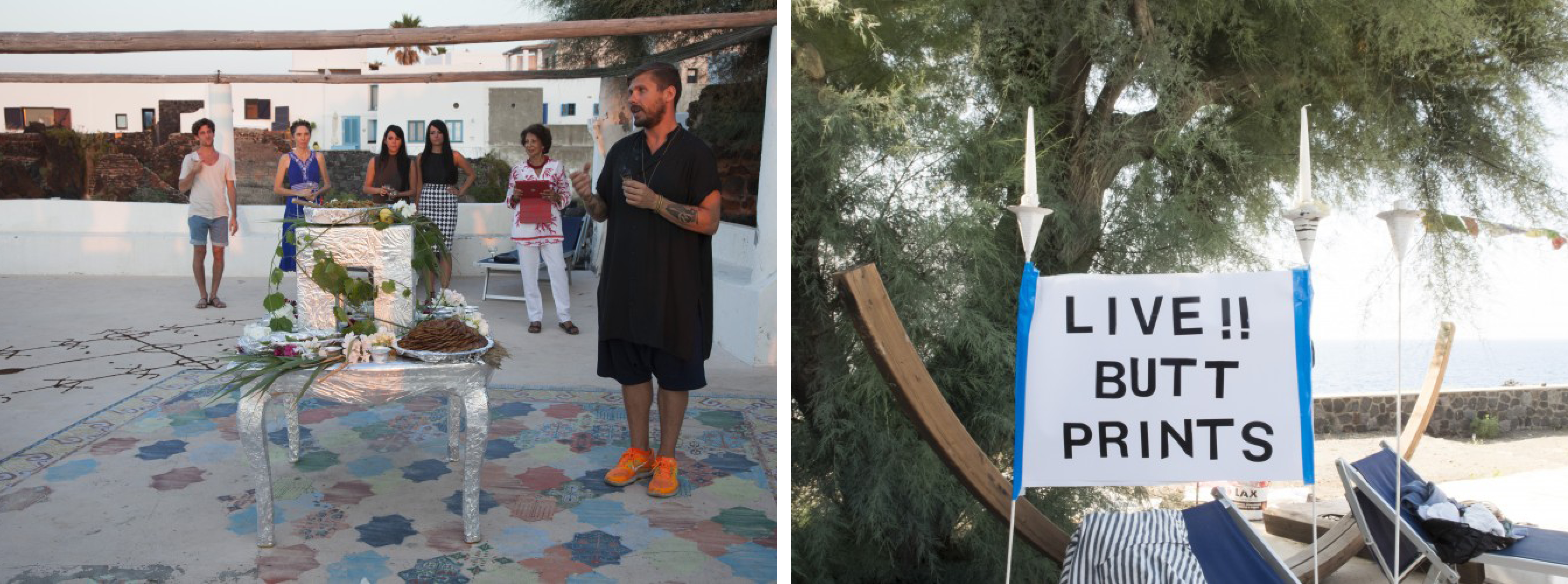
To look at the horizon and remember how things outlive us is at once a depressing and reassuring exercise. This may be why, in cities, we cover the skyline with rows of tall buildings, so we don’t have to see it all the time. In Stromboli, the sky is a sight that cannot be avoided and it is paired with the knowledge that we are standing in very close proximity of an active volcano, which has been mumbling and spitting fire uninterruptedly for over 2,000 years. The ephemerality of our being is ultimately exposed, and it’s in this very ephemerality that Mathilde Rosier’s performance, Abstracting Attraction, found a place to thrive. On the second day of Volcano Extravaganza, Rosier invited everyone to climb the volcano and find that there is no fixed point in life. Two dancers, wearing costumes that mirrored each other in their white and black designs, performed a choreography at the point when sunset and moonrise coincide. Rosier accompanied their sinuous movements with a small drum, and singing poetry, repeating the words, I am the abyss / where am I?. Yes, where were we?
According to the Tabula Smaragdina, the macrocosm is the same as the microcosm, that is to say: ‘That which is below is like that which is above and that which is above is like that which is below to do the miracles of one only thing’. This Tabula is a cryptic part of the Hermetica (Egyptian-Greek wisdom texts from II-III cent. AD) containing the secret of the prima materia and its transmutation. It forms the basis of alchemy, Hermeticism and archetypes associated with divinity and the creation of the world. Jung identified the Tablet with a table made of green stone which he encountered in the first of a set of his dreams and visions climaxing in a collection of seven mystical texts, privately published in 1916 under the title Seven Sermons to the Dead, written by Basilides of Alexandria, the city where East and West meet.
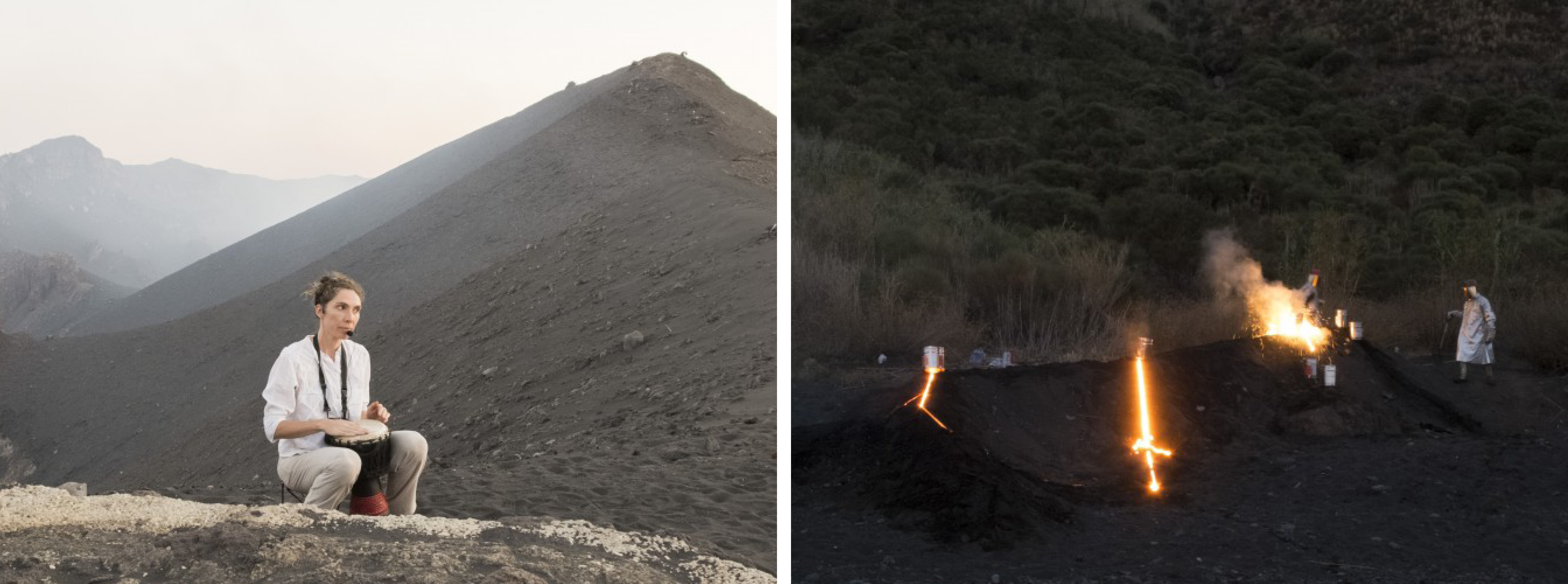
Above, on top of the volcano, the bodies melted into each other and below, on a remote beach, Raphael Hefti staged the live-welding of sculptures, employing Stromboli’s black sand as a mould. Using a mixture of finely powdered aluminium and iron oxide that produces a very high temperature on combustion (a technique widely used for railway fixings), the artist played with fire in a manner that evoked the activity the Roman god Volcano – I will not say Prometheus only to spare Hefti an affiliation with the Titan’s punishment. The artist called upon the elements of water, fire, earth and air, and they spoke through powerful alchemy.
Transformation occurs if space is made for it. The word temple, for instance, comes form the ancient Greek verb ‘temno’, that is ‘to cut’. A temple, in its origins, was conceived as a cut-off space: a circumscribed area whose limited boundaries allowed for things to happen differently. In this vein, Adriano Costa conceived a sacred meeting point by the port of Stromboli, built around a precarious wooden shed – our temple. Inside it, a young, beautiful boy dressed in a white toga sat quietly over a Ferrari tyre, his strong arm lifting up and down an engine component in a gym-like exercise. Costa staged an Olympus of new gods through icons of love, machines, excess and sexual attraction.
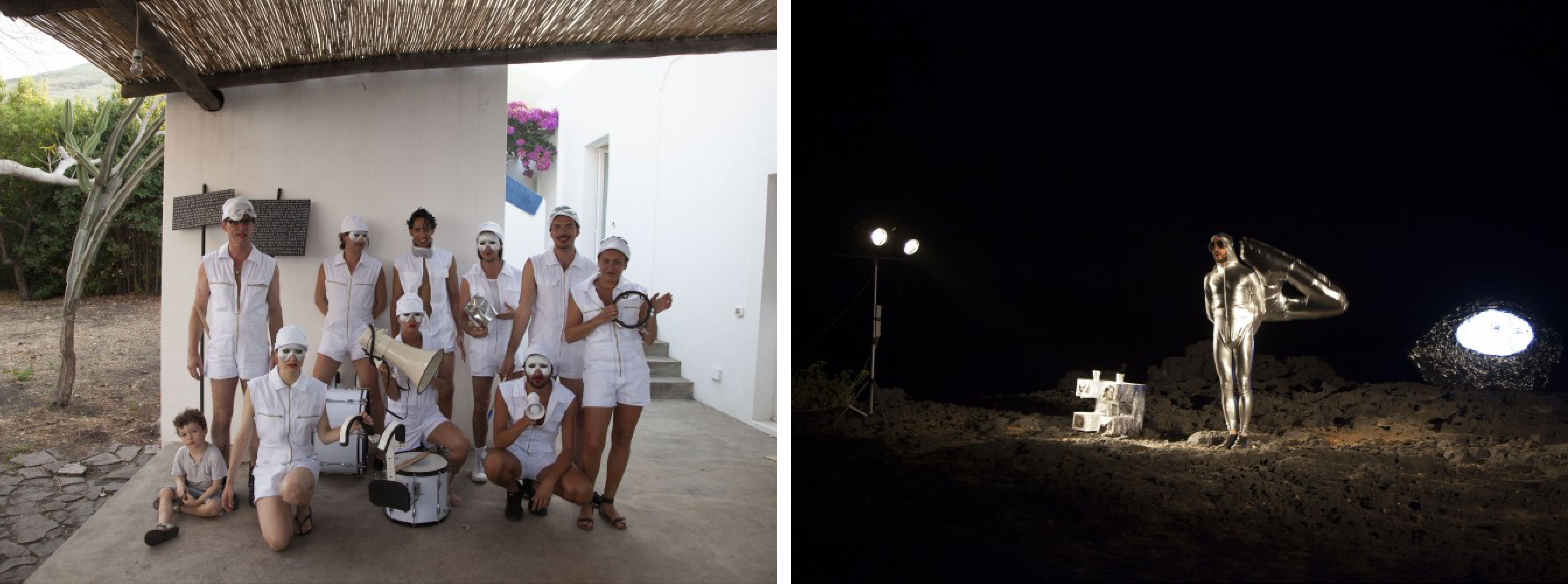
The heated atmosphere of this gathering found continuity in Thomas Zipp’s parade the following day, although the tone was completely different. Zipp invited other participating artists as well as members of the audience to wear white, zipped-up uniforms and join him to create a ceremony across the streets of Stromboli. The performers were all given an instrument to play – note that Zipp had previously ensured that none of them had any musical skills. White masks covered their faces, revealing only their eyes and mouths.
Pfahler was put in charge of the megaphone to read excerpts from Narco-Analysis by Stephen J. Horsley and The Society of the Spectacle by Guy Debord. This odd collage of references to political protests, religious processions, marching bands and military parades generated reverence and silence, as well as stupor, throughout the island. Some greeted it with the sign of the cross.
The otherworldly re-emerged several times over the course of the last days of Volcano Extravaganza. The possibility of other worlds existing some-where, some-when is so very uncanny. As Chris Kraus once wrote, no one kidnapped by the aliens has ever come back saying ‘That was the best sex I’ve ever had’. However, our attraction to the idea of the ‘other’ is indisputable – be it because we hope to stretch our horizons a bit further, or to pretend there are no horizons at all. Goshka Macuga’s alien landed in Stromboli on 25 July and delivered its first and last speech about humankind, before losing his life in an unfortunate accident with test-tube homos. More visions of the uncanny emerged during João Maria Gusmão and Pedro Paiva’s screening of short films in Ginostra, the small village on the other side of Stromboli, which until a few years ago did not have any electricity. The darkness and purity of this context seemed apt to host their presentation, which was passionately introduced by Gusmão telling the myth of the Maid of Corinth – an ancient story by Pliny the Elder, often identified with the origin of painting.
This poetry of presence and absence, of visions and eclipses, culminated on the last day with Panaiyotou presenting a very personal body of research on what he calls ‘tragic irony’ as well as literal and symbolic deaths on stage. ‘We watch them failing and we gloriously fail with them’, said Panaiyotou speaking of Greek tragedies such as Oedipus or Medea.
Early twentieth century diva Sarah Berhardt staged her official death photographic portrait while she was still young and beautiful, some twenty years before she passed away. ‘She wanted to control’ Panayiotou tells us, ‘her ultimate image, even when she would not be there to control anything, anymore’. The horizon is, indeed the biggest lie of them all.